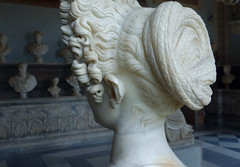

The arches on the ground level served as numbered entrances, while those of the two middle levels framed statues of gods, goddesses, and mythical and historical heroes.
FLAVIAN PORTRAITURE SERIES
The three bands below are notable for the series of arches that visually break up the massive facade. The top band is also pierced by a number of small windows, between which are engaged composite pilasters. Attached to the uppermost band are over two hundred corbels which supported the velarium - a retractable awning to protect spectators from sun and rain. The arcades are carefully designed to allow tens of thousands of spectators to enter and exit within minutes. The exterior of the Colosseum is divided into four bands that represent four interior arcades. The concrete structure is faced in travertine and marble. The Colosseum exists in part as a result of improvements in concrete and the strength and stability of Roman engineering, especially their use of the repetitive form of the arch. Like all Roman amphitheaters, the Colosseum is a free-standing structure, whose shape comes from the combination of two semi-spherical theaters. The Colosseum was home not just to gladiatorial events - because it was built over Nero’s private lake, it was flooded to stage mock naval battles.įigure 5-24: The Colosseum in Rome by Paul Zangaro is licensed under CC BY-SA 3.0 Titus inaugurated the amphitheater with a series of gladiatorial games and events that lasted for 100 days.ĭuring his reign, Domitian remodeled parts of the amphitheater to enlarge the seating capacity to hold 50,000 spectators and added a hypogeum beneath the arena, for storage and to transport animals and people to the arena floor. The building of the amphitheater began under Vespasian in 72 CE, and was completed under Titus in 80 CE. Vespasian had the colossus reworked into an image of the sun god, Sol. The amphitheater became known as the Colosseum for its size, but in also in reference to a colossal golden statue of Nero that stood nearby. Before this time, gladiatorial contests in the city were held in temporary wooden arenas. Nero’s private lake was drained and became the foundations for the amphitheater, the first permanent amphitheater built in the city of Rome. Vespasian transformed land from Nero’s Domus Aurea into public buildings for leisure and entertainment, such as the Baths of Titus and the Flavian Amphitheatre. It was a cunning political scheme to garner support from the people of Rome. Upon his succession, Vespasian began a vast building program in Rome that was continued by Titus and Domitian. Even so, his autocratic methods and policies made him unpopular with the Roman Senate, and he was assassinated in 96 CE.


Domitian expanded and secured the boundaries of Rome, repaired the damage to the city caused by the great fire, continued the building projects initiated by his brother, and improved the economy of the empire. Titus died of a fever in 81 CE and was succeeded by his brother Domitian who ruled from 81–96 CE. Ancient sources are universal in their praise for his handling of this disaster as well as the great fire of Rome in 80 CE. Titus’ early reign saw the eruption of Mount Vesuvius in 79 CE which buried the cities of Pompeii and Herculaneum. Vespasian ruled from 69–79 CE, and in that time, initiated the building of the Flavian Amphitheatre (the famous Colosseum of Rome) which his son Titus (ruled 79–81 CE) would complete. Vespasian founded the Flavian Dynasty which was characterized by massive building projects, economic prosperity, and expansion of the empire. Nero’s suicide ended the Julio-Claudian Dynasty and initiated the period of social unrest but ultimately found stability under the emperor Vespasian. This trend would continue, more or less steadily, with the emperors who followed: Caligula, Claudius, and Nero. Following Augustus’ death, power passed to his heir, Tiberius, who continued many of the emperor’s policies but lacked the strength of character and vision which so defined Augustus.


 0 kommentar(er)
0 kommentar(er)
